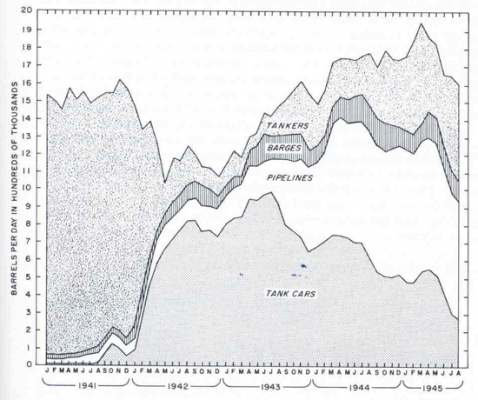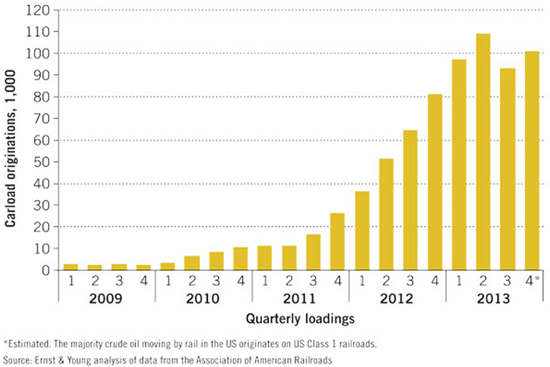 Recent weeks have seen a number of destructive explosions following oil train derailments in several U.S. states. These disasters follow a dramatic increase in the number of new oil tank cars on the rails since 2011 which are associated with the boom in unconventional oil extraction in states such as North Dakota. Jeff D. Makholm examines why so many dangerous oil tank cars are on the rails, arguing that the main cause is a lack of federal licencing authority over oil pipelines. He writes that oil pipelines in America are governed by a myriad of regulatory agencies and authorities which makes expanding the pipeline system difficult and costly. If Congress wants to make oil transportation safer, it should look to the gas industry’s regulatory model for inspiration on which reforms to put into place.
Recent weeks have seen a number of destructive explosions following oil train derailments in several U.S. states. These disasters follow a dramatic increase in the number of new oil tank cars on the rails since 2011 which are associated with the boom in unconventional oil extraction in states such as North Dakota. Jeff D. Makholm examines why so many dangerous oil tank cars are on the rails, arguing that the main cause is a lack of federal licencing authority over oil pipelines. He writes that oil pipelines in America are governed by a myriad of regulatory agencies and authorities which makes expanding the pipeline system difficult and costly. If Congress wants to make oil transportation safer, it should look to the gas industry’s regulatory model for inspiration on which reforms to put into place.
Oil tank cars exploded again a few weeks ago in northern Illinois, following a similar scene last month in West Virginia, in the Ontario wilderness a week before that, Lynchburg, Virginia in 2014 and Lac-Mégantic, Ontario in 2013 (which killed 47). Rail shipments of oil are at least six times as costly, and more dangerous, than the movement of oil by modern pipelines. And yet, 40,000 new oil tank cars have appeared on the rails since 2011.
There have been three booms in the use of railroad tank cars to move America’s crude oil. Two made sense. The first occurred when the industry displaced the transport of oil in 42-gallon wooden barrels loaded in railroad box cars (Standard Oil had about 10,000 tank cars in 1904). As Figure 1 shows, the second occurred in 1942 when U-boats became the scourge of the Atlantic seaboard—the principal oil route to the East Coast from Texas. Given the war emergency, rail tank cars delivered one million barrels per day to the East Coast by the middle of 1943 (from almost nothing in 1941).
Figure 1 – Deliveries of Oil to the US East Coast 1941-1945, the Second Explosion of Oil Rail Cars

Source: Johnson, Petroleum Pipelines and Public Policy, Harvard, 1967.
The third boom started in 2011, shown in Figure 2, with rapidly increasing unconventional oil production in North Dakota and Alberta and a 10-fold expansion of the use of such oil tank cars.
Figure 2 – U.S Crude-by-rail growth 2009 – 2013

So why do 40,000 new tank cars roam the rails of North America while safer and much more economical oil pipelines stall? The main cause is a vacuum of federal licensing authority over oil pipelines. That vacuum makes the business of expanding America’s oil pipeline system litigious, uncertain and highly political. America treats its natural gas pipelines differently, having put them under the licensing authority of its expert agency, the Federal Energy Regulatory Commission (the FERC). That agency oversees the nation’s extensive natural gas pipelines that make America’s highly competitive natural gas market work—a market that has saved Americans half a trillion dollars in natural gas costs over the past six years compared to their counterparts in the European Union. And yet, the FERC’s natural gas division costs Americans only about $36 million annually (from the 2014 federal budget). It is hard to think of a regulatory agency that so benefits the American economy for so little money.
Without fanfare or particularly newsworthy political fights, acting under authority given by Congress in the 1930s, the FERC licenses thousands of miles of new gas pipelines every year in a decades-long collaboration with the Environmental Protection Agency, the U.S. Department of Transportation (Pipeline and Hazardous Materials Safety Administration) and the U.S. Army Corps of Engineers. But the FERC cannot apply its depth of expertise to oil pipelines; it is barred from doing so under the 1906 law governing those pipelines. Thus, authority over oil pipelines devolves to an array of less competent and more political agencies. The State Department judges the environmental impact and public interest of the Keystone XL pipeline, private parties wage major courtroom battles over straightforward pipeline links and local authorities (like Wisconsin’s Dane County zoning committee) hold up major oil pipeline expansions. Hence, expanding the nation’s oil pipeline system is difficult, uncertain and highly political, and the tank cars fill the gap.
Congress has an understandable aversion to petroleum industry legislation, acting only when the public demands it. The 1906 law came only after Ida Tarbell’s 1904 exposé of widespread monopolistic abuse turned public opinion against Standard Oil. The 1930s gas pipeline law, giving FERC such useful powers, came only after public opinion demanded the end of the abuses of American consumers at the hands of unregulated multi-state natural gas holding companies (the Enrons of their era). The evident problems with greatly expanded rail shipments should give Congress the excuse to bring its oil industry into the modern era. Rail cars do serve a useful role in the petroleum industry when cheaper and safer long-distance shipping options (like barges, tankers and pipelines) are not feasible. But giving to the FERC the central licensing authority for oil pipelines that it already applies to thousands of miles of large and small new natural gas pipelines every year would serve to limit this third, senseless, boom in the movement of oil in America by rail.
Featured image credit: Roy Luck (Flickr, CC-BY-2.0)
Please read our comments policy before commenting.
Note: This article gives the views of the author, and not the position of USApp– American Politics and Policy, nor of the London School of Economics.
Shortened URL for this post: http://bit.ly/1HXOMDE
_________________________________
 Jeff D. Makholm – National Economic Research Associates
Jeff D. Makholm – National Economic Research Associates
Jeff D. Makholm is an economist with National Economic Research Associates (NERA) in Boston Massachusetts. He has long researched the role of pipelines in energy markets. His latest book, The Political Economy of Pipelines, was published by the University of Chicago Press in 2012.






